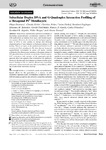Subcellular duplex DNA and G‐quadruplex interaction profiling of a hexagonal PtII metallacycle

Use este enlace para citar
http://hdl.handle.net/2183/23720
Excepto si se señala otra cosa, la licencia del ítem se describe como Atribución-NoComercial 4.0 España
Colecciones
- Investigación (FCIE) [1227]
Metadatos
Mostrar el registro completo del ítemTítulo
Subcellular duplex DNA and G‐quadruplex interaction profiling of a hexagonal PtII metallacycleAutor(es)
Fecha
2019-04-19Cita bibliográfica
O. Domarco, C. Kieler, C. Pirker, C. Dinhof, B. Englinger, J. M. Reisecker, G. Timelthaler, M. D. García, C. Peinador, B. K. Keppler, W. Berger, A. Terenzi, Angew. Chem. Int. Ed. 2019, 58, 8007.
Resumen
[Abstract] Metal‐driven self‐assembly afforded a multitude of fascinating supramolecular coordination complexes (SCCs) with applications as catalysts, host–guest, and stimuli‐responsive systems. However, the interest in the biological applications of SCCs is only starting to emerge and thorough characterization of their behavior in biological milieus is still lacking. Herein, we report on the synthesis and detailed in‐cell tracking of a Pt2L2 metallacycle. We show that our hexagonal supramolecule accumulates in cancer cell nuclei, exerting a distinctive blue fluorescence staining of chromatin resistant to UV photobleaching selectively in nucleolar G4‐rich regions. SCC co‐localizes with epitopes of the quadruplex‐specific antibody BG4 and replaces other well‐known G4 stabilizers. Moreover, the photophysical changes accompanying the metallacycle binding to G4s in solution (fluorescence quenching, absorption enhancement) also take place intracellularly, allowing its subcellular interaction tracking.
Palabras clave
G-quadruplex
Metallacycle
Platinum
SCC
Subcellular localization
Metallacycle
Platinum
SCC
Subcellular localization
Versión del editor
Derechos
Atribución-NoComercial 4.0 España
ISSN
1433-7851
1521-3773
1521-3773






